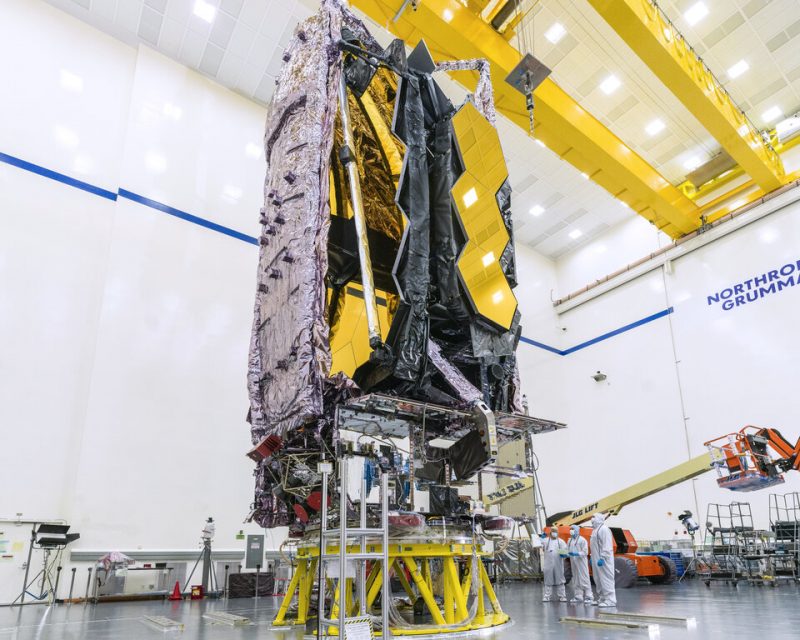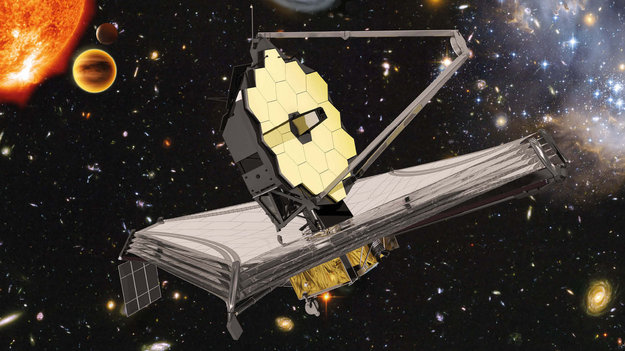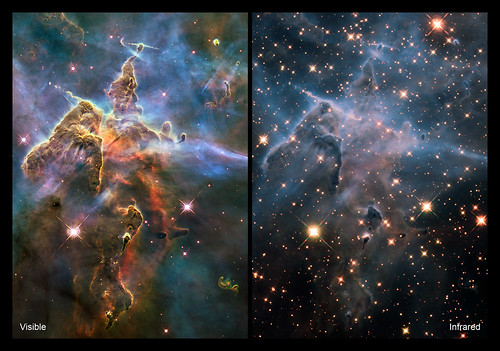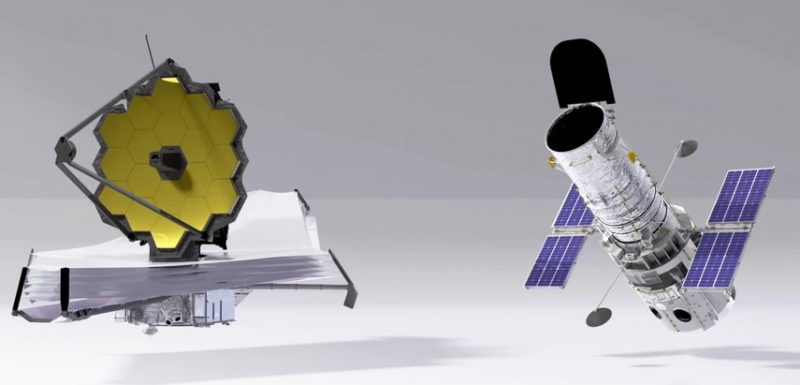
Webb Telescope is Hubble’s successor
Alright! The European Space Agency (ESA) said on August 26, 2021 that the James Webb Space Telescope has successfully completed its final tests. It’s now being prepared for shipment to its launch site from the ELA-3 launch site at the European Spaceport located near Kourou, French Guiana. Webb is an international partnership between NASA, ESA and the Canadian Space Agency. NASA had said on June 3 that the telescope would ship to the launch site “in August with little to no schedule margin.” That tight schedule would bring the telescope to launch readiness no earlier than October 31. But a November launch may still be more likely.
The space telescope has been undergoing testing at Northrop Grumman’s facilities in California. ESA said:.
Shipment operations have now begun, including all the necessary steps to prepare Webb for a safe journey through the Panama Canal to its launch location in French Guiana, on the northeastern coast of South America.
Once Webb arrives at Europe’s Spaceport, launch processing teams will prepare and configure the observatory for flight. This involves post-shipment checkouts and carefully loading the spacecraft’s propellant tanks with fuel. Then, engineering teams will mate the observatory to its launch vehicle, an Ariane 5 rocket provided by ESA and make a ‘dress rehearsal’, before it rolls out to the launch pad two days before launch.

Launch from near Earth’s equator
The upper stage of the Ariane 5, which will carry Webb to space later this year, is already on its way to Europe’s Spaceport. Overnight on 17 August 2021, the upper stage was transported in its container from ArianeGroup in Bremen to Neustadt port in Germany. Here it boarded the MN Toucan vessel alongside other Ariane 5 elements loaded in various European harbours to continue its journey to Kourou, French Guiana.
Following launch, the massive space observatory will then make its way to Lagrange Point 2, a gravitationally stable point 930,000 miles (1.5 million km) from our planet. Webb will take about a month to fly to this location in space. As it travels there, beginning a few days after launch, it’ll begin slowly unfolding its biggest feature, its tennis court-sized sunshield, designed to reduce the sun’s heat by more than a million times, to -364 degrees F (-220 degrees C). Webb’s mirror and instrumentation have to be kept cold. If they were to be heated up by the sun, they’d give off infrared radiation. And it’s faint infrared signals from the distant cosmos that the Webb is meant to measure. ESA commented that each step of the cool-down procewss:
… Can be controlled expertly from the ground, giving Webb’s launch full control to circumnavigate any unforeseen issues with deployment.
ESA said the mission team can manage the cool-down, which will take several weeks, with heaters to control stresses on instruments and structures. In the meantime, ESA said:
… The secondary mirror tripod will unfold, the primary mirror will unfold, Webb’s instruments will slowly power up, and thruster firings will insert the observatory into a prescribed orbit.
After orbit insertion, and after the telescope has cooled down and stabilized at its frigid operating temperature, the mission team will spend several months aligning its optics and calibrating its scientific instruments. Then Webb will begin studying the cosmos in infrared light using its dazzling golden mirror.

What’s huge, grand, and golden?
One of the Webb’s most important and identifiable attributes is its 21-foot-wide (6.5-meter-wide) primary mirror. A reflecting telescope’s primary mirror determines how much light it can collect, and thus how deeply it can see into the universe. Webb’s mirror is nearly three times wider than Hubble’s primary mirror.
You might hear people speak of the Webb’s golden mirror. The mirror is actually multiple mirrors. It’s composed of 18 separate hexagonal-shaped segments made of very strong, ultra-lightweight beryllium, which will unfold after launch. Each of the telescope’s mirror segments are covered in a microscopically thin layer of gold. This gold covering optimizes the mirror segments for reflecting infrared light, which is the primary wavelength of light this telescope will observe.
Webb Telescope’s long road
The Webb’s development began in 1996, with a $500 million budget. Space scientists and engineers initially planned the launch for 2007. But the project has had considerable delays and cost overruns, and it underwent a major redesign in 2005. Afterwards, they planned the launch for March 2020, but the coronavirus pandemic struck and has caused major setbacks. Yet, now, the team has made significant progress. NASA says existing program funding will have the Webb finished within its current $8.8 billion cost cap. In December 2020, the sunshield of a fully assembled James Webb Space Telescope successfully completed its own final tests, including a complete unfolding, just as the telescope will need to do once in space.
Formerly known as the Next Generation Space Telescope, scientists renamed the Webb in September 2002 after James Webb, who was an esteemed former NASA administrator.
The entire project is an international collaboration between NASA, the European Space Agency, and the Canadian Space Agency. NASA’s Goddard Space Flight Center in Greenbelt, Maryland, manages the development effort, while Northrop Grumman serves as the project’s main industrial partner.
As it did for the Hubble Space Telescope, the Space Telescope Science Institute in Baltimore will be operating the Webb telescope after launch.

Technologies advance
As you would expect, the capabilities of the Webb extend beyond those of the Hubble Space Telescope. NASA likes to say that the Webb is not a replacement for Hubble, but rather a successor. The two telescopes will collaborate side by side for a while, with a planned overlap.
The Webb will observe farther into the infrared regions of the electromagnetic spectrum than Hubble. It’ll go even deeper into space than Hubble, and thus it’ll look further into the past. It’ll be able to peer inside stellar dust clouds where stars and star systems form. Thaddeus Cesari, a communications specialist for the mission, wrote:
In addition to the groundbreaking science expected from it after launch, Webb has required an improvement in the testing infrastructure and processes involved in validating large complex spacecraft for a life in space … Lessons learned from previous space telescope development were invested into Webb, and future space telescopes will be built upon the same collective knowledge. Thousands of scientists, engineers, and technicians contributed to build, test, and integrate Webb. In total, 258 companies, agencies, and universities participated: 142 from the United States, 104 from 12 European nations, and 12 from Canada.

Who will use the Webb?
The Webb will be the largest, most powerful and most complex infrared telescope ever built. Thousands of astronomers worldwide will use it for a wide range of research projects, complementing and extending the discoveries of the Hubble Space Telescope, as well as the now-decommissioned Spitzer infrared space telescope.
Once in space, above Earth’s obscuring atmosphere, the Webb is expected to provide unobstructed views of the near and distant cosmos. Since light has a finite speed (186,000 miles per second, or 300,000 km per second), the new space telescope will also provide insights into our universe’s past: from the first light after the Big Bang, to the formation and evolution of galaxies, to our own and other planetary systems.
Thus, the Webb will be used for study of every phase in the history of our universe.

Your new wallpaper
NASA selected 22 artists nationwide to attend the James Webb Space Telescope Artist Event at the Goddard Spaceflight Center in Greenbelt, Maryland. The artists sat directly in front of the Webb telescope while being briefed on the mission by scientists, engineers and other project personnel. As they listened, they worked; sketching, painting, writing, sewing, playing music. Visit this gallery to see their astonishing impressions of the Webb and its mission.
Bottom line: The James Webb Space Telescope is the world’s most complex infrared telescope. On June 1, 2021, European Space Agency representatives and Arianespace officials announced that the launch of the Webb will likely slip from October 31 to at least mid-November.
Read more from EarthSky: James Webb Space Telescope passes environmental testing
The post Webb Telescope completes tests, aims Europe’s Spaceport first appeared on EarthSky.
from EarthSky https://ift.tt/3vVbPv9

Webb Telescope is Hubble’s successor
Alright! The European Space Agency (ESA) said on August 26, 2021 that the James Webb Space Telescope has successfully completed its final tests. It’s now being prepared for shipment to its launch site from the ELA-3 launch site at the European Spaceport located near Kourou, French Guiana. Webb is an international partnership between NASA, ESA and the Canadian Space Agency. NASA had said on June 3 that the telescope would ship to the launch site “in August with little to no schedule margin.” That tight schedule would bring the telescope to launch readiness no earlier than October 31. But a November launch may still be more likely.
The space telescope has been undergoing testing at Northrop Grumman’s facilities in California. ESA said:.
Shipment operations have now begun, including all the necessary steps to prepare Webb for a safe journey through the Panama Canal to its launch location in French Guiana, on the northeastern coast of South America.
Once Webb arrives at Europe’s Spaceport, launch processing teams will prepare and configure the observatory for flight. This involves post-shipment checkouts and carefully loading the spacecraft’s propellant tanks with fuel. Then, engineering teams will mate the observatory to its launch vehicle, an Ariane 5 rocket provided by ESA and make a ‘dress rehearsal’, before it rolls out to the launch pad two days before launch.

Launch from near Earth’s equator
The upper stage of the Ariane 5, which will carry Webb to space later this year, is already on its way to Europe’s Spaceport. Overnight on 17 August 2021, the upper stage was transported in its container from ArianeGroup in Bremen to Neustadt port in Germany. Here it boarded the MN Toucan vessel alongside other Ariane 5 elements loaded in various European harbours to continue its journey to Kourou, French Guiana.
Following launch, the massive space observatory will then make its way to Lagrange Point 2, a gravitationally stable point 930,000 miles (1.5 million km) from our planet. Webb will take about a month to fly to this location in space. As it travels there, beginning a few days after launch, it’ll begin slowly unfolding its biggest feature, its tennis court-sized sunshield, designed to reduce the sun’s heat by more than a million times, to -364 degrees F (-220 degrees C). Webb’s mirror and instrumentation have to be kept cold. If they were to be heated up by the sun, they’d give off infrared radiation. And it’s faint infrared signals from the distant cosmos that the Webb is meant to measure. ESA commented that each step of the cool-down procewss:
… Can be controlled expertly from the ground, giving Webb’s launch full control to circumnavigate any unforeseen issues with deployment.
ESA said the mission team can manage the cool-down, which will take several weeks, with heaters to control stresses on instruments and structures. In the meantime, ESA said:
… The secondary mirror tripod will unfold, the primary mirror will unfold, Webb’s instruments will slowly power up, and thruster firings will insert the observatory into a prescribed orbit.
After orbit insertion, and after the telescope has cooled down and stabilized at its frigid operating temperature, the mission team will spend several months aligning its optics and calibrating its scientific instruments. Then Webb will begin studying the cosmos in infrared light using its dazzling golden mirror.

What’s huge, grand, and golden?
One of the Webb’s most important and identifiable attributes is its 21-foot-wide (6.5-meter-wide) primary mirror. A reflecting telescope’s primary mirror determines how much light it can collect, and thus how deeply it can see into the universe. Webb’s mirror is nearly three times wider than Hubble’s primary mirror.
You might hear people speak of the Webb’s golden mirror. The mirror is actually multiple mirrors. It’s composed of 18 separate hexagonal-shaped segments made of very strong, ultra-lightweight beryllium, which will unfold after launch. Each of the telescope’s mirror segments are covered in a microscopically thin layer of gold. This gold covering optimizes the mirror segments for reflecting infrared light, which is the primary wavelength of light this telescope will observe.
Webb Telescope’s long road
The Webb’s development began in 1996, with a $500 million budget. Space scientists and engineers initially planned the launch for 2007. But the project has had considerable delays and cost overruns, and it underwent a major redesign in 2005. Afterwards, they planned the launch for March 2020, but the coronavirus pandemic struck and has caused major setbacks. Yet, now, the team has made significant progress. NASA says existing program funding will have the Webb finished within its current $8.8 billion cost cap. In December 2020, the sunshield of a fully assembled James Webb Space Telescope successfully completed its own final tests, including a complete unfolding, just as the telescope will need to do once in space.
Formerly known as the Next Generation Space Telescope, scientists renamed the Webb in September 2002 after James Webb, who was an esteemed former NASA administrator.
The entire project is an international collaboration between NASA, the European Space Agency, and the Canadian Space Agency. NASA’s Goddard Space Flight Center in Greenbelt, Maryland, manages the development effort, while Northrop Grumman serves as the project’s main industrial partner.
As it did for the Hubble Space Telescope, the Space Telescope Science Institute in Baltimore will be operating the Webb telescope after launch.

Technologies advance
As you would expect, the capabilities of the Webb extend beyond those of the Hubble Space Telescope. NASA likes to say that the Webb is not a replacement for Hubble, but rather a successor. The two telescopes will collaborate side by side for a while, with a planned overlap.
The Webb will observe farther into the infrared regions of the electromagnetic spectrum than Hubble. It’ll go even deeper into space than Hubble, and thus it’ll look further into the past. It’ll be able to peer inside stellar dust clouds where stars and star systems form. Thaddeus Cesari, a communications specialist for the mission, wrote:
In addition to the groundbreaking science expected from it after launch, Webb has required an improvement in the testing infrastructure and processes involved in validating large complex spacecraft for a life in space … Lessons learned from previous space telescope development were invested into Webb, and future space telescopes will be built upon the same collective knowledge. Thousands of scientists, engineers, and technicians contributed to build, test, and integrate Webb. In total, 258 companies, agencies, and universities participated: 142 from the United States, 104 from 12 European nations, and 12 from Canada.

Who will use the Webb?
The Webb will be the largest, most powerful and most complex infrared telescope ever built. Thousands of astronomers worldwide will use it for a wide range of research projects, complementing and extending the discoveries of the Hubble Space Telescope, as well as the now-decommissioned Spitzer infrared space telescope.
Once in space, above Earth’s obscuring atmosphere, the Webb is expected to provide unobstructed views of the near and distant cosmos. Since light has a finite speed (186,000 miles per second, or 300,000 km per second), the new space telescope will also provide insights into our universe’s past: from the first light after the Big Bang, to the formation and evolution of galaxies, to our own and other planetary systems.
Thus, the Webb will be used for study of every phase in the history of our universe.

Your new wallpaper
NASA selected 22 artists nationwide to attend the James Webb Space Telescope Artist Event at the Goddard Spaceflight Center in Greenbelt, Maryland. The artists sat directly in front of the Webb telescope while being briefed on the mission by scientists, engineers and other project personnel. As they listened, they worked; sketching, painting, writing, sewing, playing music. Visit this gallery to see their astonishing impressions of the Webb and its mission.
Bottom line: The James Webb Space Telescope is the world’s most complex infrared telescope. On June 1, 2021, European Space Agency representatives and Arianespace officials announced that the launch of the Webb will likely slip from October 31 to at least mid-November.
Read more from EarthSky: James Webb Space Telescope passes environmental testing
The post Webb Telescope completes tests, aims Europe’s Spaceport first appeared on EarthSky.
from EarthSky https://ift.tt/3vVbPv9

Aucun commentaire:
Enregistrer un commentaire